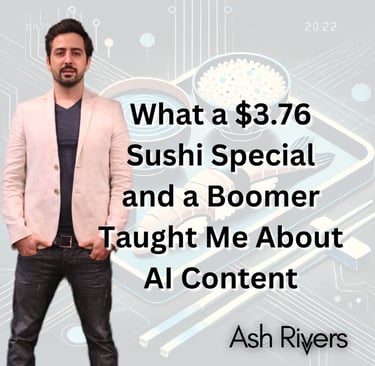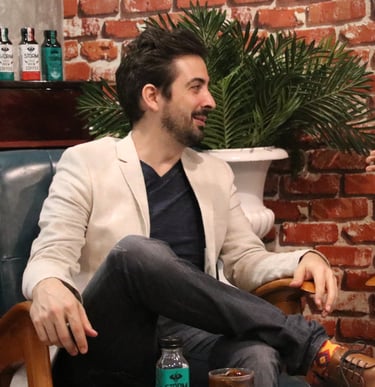What a $3.76 Sushi Special and a Boomer Taught Me About AI Content
AI has made content cheap, fast, and endless—so how do SMBs stand out? This article explores why trust, personal branding, and micro-influencers are the real competitive edge in a world flooded with AI-generated noise.
MARKETING AND CONTENT
The sushi place on the "dark side" of Pattaya, Thailand, was running a lunch special: miso soup, two pieces of sushi, a saba fish fillet over rice—$3.76.
I don’t know how a restaurant is turning a profit on that, but I wasn’t about to ask questions.
Across the table sat my 68-year-old neighbor, a semi-retired-from-the-cruise-industry guy who spends his time tinkering with tech. Between bites of sashimi, he started explaining how to use AI to pull content from YouTube or other sources and generate social posts, blog articles, and email newsletters—on autopilot.
He's not doing this for a business. He is simply enjoying putting all the various AI tools to use just because he can.
And that’s when it hit me.
I already knew AI was cheap, fast, and accessible. That’s not new. But sitting across from this guy, listening to him lay out a fully functional content automation system in the same breath as he fretted over his retirement savings holding up?
That was different.
That was the moment I realized just how far and fast AI has come. Not in theory, not in a tech article, but right in front of me, over a $3.76 lunch special.
It made something very clear: If AI-generated content is this easy, this available—then I need to sprint in the opposite direction.
Let’s talk about why.
The Content Flood: AI Has Flattened the Playing Field
Not that long ago, especially in certain industries and markets, producing content was a differentiator. If you blogged consistently, published thought leadership, and posted on LinkedIn, you were ahead of the curve.
Now? Every company can do that at scale with AI.
SEO-driven articles? Automated.
LinkedIn thought "leadership"? Churned out in minutes. (Obviously this wouldn't be true thought leadership, but it can certainly have the veneer of it.)
Email campaigns? Generated, scheduled, and optimized by an algorithm.
I see AI-generated content swirling around my search results. I click away from AI voice-over and image videos faster than a teenager closing a browser tab in the 2000s. The problem with purely AI or primarily AI-generated content is that it all sounds and looks the same. When a human uses AI to generate, say, 50% or more of the content, it turns out inoffensive, neatly structured, and completely forgettable. To be clear, I used ChatGPT to help with this article. Looking back at the prompts, I used AI as a tool for correcting grammar, generating a restructured LinkedIn version, and creating a meta description. I didn’t ask AI to generate the idea or even write a draft. I find that when I have AI start the draft, I end up following it too closely—almost like I’m writing an article for AI… weird.
If your content strategy is still “let’s just publish more”, you’re not competing. You’re contributing to the landfill.
How I Think SMBs Actually Win in This Content Environment
I start by asking, "if AI has made content infinite, then what’s scarce?"
I posit: Trust. Attention. Real relationships.
That’s what people are looking for. And that’s what I'm advising customers to optimize for. Here's my trifecta approach that builds up Trust, Attention, and Real Relationships:
Your organization's branded content
Key personnel within your organizations' personal brands
Pay for niche influencers
Let's look at each of these.
1. The Organization’s Brand Content (The Business Perspective)
Your brand content should be your company’s point of view, not just content for the sake of content.
Have a real stance. AI plays it safe. Don’t.
Show your work. Case studies, inside looks, and behind-the-scenes insights.
Talk like a person. No one cares about “solutions-driven synergies.”
Brand content shouldn’t be a content mill. It should be a credibility engine.
2. Personal Brands Inside the Business (The Human Perspective)
People trust people more than they trust brands.
This means:
The CEO and key team members need a voice.
They should be sharing personal insights, industry takes, and real stories.
Not polished corporate speak—real, messy-ish, honest content.
Companies that hide behind logos and press releases get ignored. Companies that let their people be seen build trust.
3. Paying for Trust: Nano & Micro-Influencers
Not all trust has to be built from scratch. Nor do most businesses require a household name to promote their products. In fact, a lesser known person is probably a better match and a lot easier on the marketing budget.
Nano-influencers (250+ followers) and micro-influencers (10k-100k) have niche, highly engaged audiences.
Businesses can tap into these existing networks instead of screaming into the void.
Sponsored collaborations, guest content, and partnerships accelerate credibility.
Influencer marketing isn’t just for B2C. It’s about leveraging high-trust voices in specific industries.
Is This Advice For You?
Only you can look at your organization and decide if some of what I've said sounds reasonable and useful. But my take is that not every SMB is ready for all three areas of content marketing that I laid out above.
If you’re under $5M to $7M in revenue, you probably just need to get the basics right first.
A website that doesn’t look like it was built in 2009.
A clear message that tells customers what you actually do.
A simple, consistent content presence.
But if you’re past that stage, and you’re looking to actually build long-term brand authority, then this three-pronged strategy is where I’d start.
Stick the Landing: Maybe All They Really Want Is a $3.76 Lunch
Back at the sushi place, my neighbor kept talking about AI content automation and where to find cheap desserts while I stared at the check.
$3.76.
And I thought: Maybe this is the real takeaway.
Maybe at the end of the day, customers don’t want a perfectly crafted, deeply insightful, emotionally resonant brand narrative. Maybe they just want a great deal, a great experience, and someone they trust to deliver it.
Maybe, in a world flooded with AI-generated noise, clarity and value are the only things left that actually matter.
What a $3.76 Sushi Special and a Boomer Taught Me About AI Content
A Sushi Lunch, the Content Tidal Wave, and What I'm Doing Next


Brandon Alsup is the founder of Ash Rivers, a marketing and media consulting firm specializing in MSPs and SMBs.
Brandon has been running the Marketing Department for Kosh Solutions since 2020.






